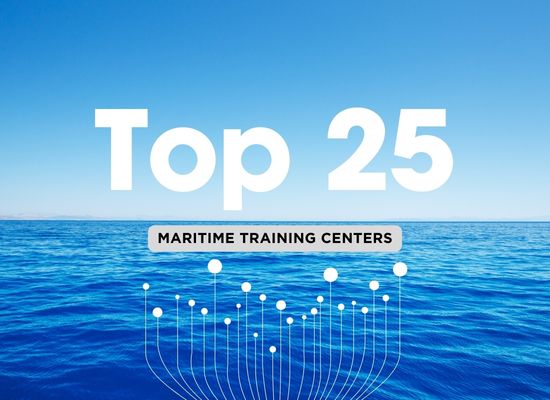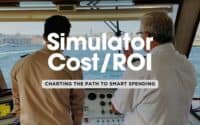Top 25 Maritime Schools and Training Centers Across the World

Navigating the world of maritime education can be as challenging as steering a vessel through stormy waters. Knowing where to get the best training is crucial. Let’s dive into 25 of the top maritime training centers around the globe that have consistently stood out for their excellence.
🚢 ShipUniverse Weekly Newsletter – Free. No fluff. Just key maritime insights 📬
* Please send feedback/suggestions to editor @ shipuniverse.com
** Please confirm tuition figures as as costs at these schools fluctuate.
1. World Maritime University (WMU) – Malmö, Sweden
- Overview: Founded by the International Maritime Organization (IMO) in 1983, WMU has cemented its reputation as a premier global institution for postgraduate maritime education.
- Programs: It offers MSc programs in Maritime Affairs, Ph.D. programs, and various professional development courses.
- Facilities: A state-of-the-art maritime library, research facilities, and modern teaching equipment.
- Cost: Tuition fees for the standard MSc program are around USD $20,000 – $30,000, excluding living expenses. Scholarships and financial aid options are available.
2. Nautical Institute – London, UK
- Overview: Founded in 1972, the Nautical Institute is a non-governmental organization representing maritime professionals.
- Services: While not a traditional educational institution, it provides various publications, specialized courses, and accreditations for maritime training.
- Recognitions: Renowned for its standard-setting publications on bridge procedures and ship handling.
- Cost: Membership fees vary, but for full members, it’s approximately GBP 150-200 annually. Course and publication costs are separate.
3. Maritime and Coastguard Agency (MCA) – UK
- Overview: The MCA is an executive agency of the UK government, overseeing maritime safety. It doesn’t provide training directly but approves maritime training institutions in the UK.
- Function: It ensures training institutions uphold the standards set by the International Maritime Organization (IMO).
- Recognition: Attending an MCA-approved course is often a sign of receiving top-tier maritime education.
- Cost: As it’s an agency that endorses and regulates rather than provides training, there’s no fixed tuition. However, course costs will vary based on the institution and program you select.
4. Norwegian Maritime University (NMU) – Ålesund, Norway
- Overview: NMU is a central institution in Norway providing specialized education in maritime studies.
- Programs: Bachelor’s and Master’s degrees in nautical studies, maritime engineering, and related fields.
- Facilities: Features state-of-the-art simulators, workshops, and laboratories.
- Cost: As with other public universities in Norway, there’s no tuition fee for domestic and international students. However, students are expected to cover their living expenses.
5. Marine Engineering and Research Institute (MERI) – Kolkata, India
- Overview: Established in 1947, MERI is one of India’s top institutions for marine engineering and research.
- Programs: Primarily offers a Bachelor’s degree in Marine Engineering and a few postgraduate and diploma courses.
- Facilities: Includes modern engine room simulators, workshops, and laboratories.
- Cost: The tuition fee for the Bachelor’s program for resident students is around INR 225,000 per year (roughly USD 3,000). International student fees may differ.
6. United States Merchant Marine Academy (USMMA) – Kings Point, New York, USA
- Overview: Founded in 1943, USMMA is a renowned federal service academy that has been at the forefront of maritime education in the U.S.
- Programs: It offers a Bachelor of Science degree with various marine-related majors, and all graduates also earn a U.S. Coast Guard license.
- Facilities: Features state-of-the-art simulators, shipboard training, and other modern amenities.
- Cost: As a federal service academy, students (known as midshipmen) have their tuition covered but commit to a service obligation after graduation.
7. Singapore Maritime Academy, Singapore Polytechnic – Singapore
Overview: As a division of Singapore Polytechnic, the Singapore Maritime Academy has become a leading institution for maritime education in Asia.
- Programs: Offers diploma courses in Marine Engineering, Maritime Business, and Nautical Studies.
- Facilities: Modern simulators, training workshops, and a marine laboratory.
- Cost: The fees differ depending on the program. The yearly fees for Diploma in Maritime Business for international students iss around SGD 12,000 – 15,000 (about USD 10,500).
8. Australian Maritime College (AMC) – Launceston, Tasmania
- Overview: Established in 1980, the AMC is an institute of the University of Tasmania and stands as Australia’s premier maritime education facility.
- Programs: Ranges from undergraduate degrees to postgraduate programs and vocational training in maritime engineering, logistics, seafaring, and more.
- Facilities: Advanced training vessels, simulators, towing tank, and model test basin.
- Cost: Tuition varies by program. For example, the Bachelor of Applied Science (Marine Engineering) program’s annual fee is approximately AUD 30,000 for international students.
9. Nippon Kaiji Kyokai (ClassNK) – Japan
- Overview: Primarily known as a ship classification society, ClassNK also engages in maritime training, especially in ship safety and operations.
- Services: Training courses related to ship classification, surveys, and maritime regulations.
- Recognition: One of the world’s leading classification societies with a rich history dating back to 1899.
- Cost: Fees vary depending on the specific training or service sought.
10. Maritime Institute of Technology and Graduate Studies (MITAGS) – Linthicum Heights, Maryland, USA
- Overview: MITAGS is a leading maritime training center in the United States, specializing in advanced simulation-based training and professional development for maritime professionals. It serves both individual mariners and corporate clients, providing a range of courses that meet international and U.S. Coast Guard standards.
- Programs: Offers U.S. Coast Guard-approved courses, STCW (Standards of Training, Certification, and Watchkeeping) training, navigation and ship handling, engineering and engine room resource management, leadership and management training, and marine safety and firefighting.
- Facilities: Features state-of-the-art full-mission bridge simulators, engine room simulators, firefighting training facilities, and conference accommodations for maritime professionals.
- Cost: Course fees range from USD $500 to $10,000, depending on the program. Customized corporate training packages are also available.
- Overview: Established in 1929, Cal Maritime is one of seven degree-granting maritime academies in the United States, offering a hands-on education that prepares students for careers in the maritime industry.
- Programs: Offers undergraduate degrees in International Business and Logistics, Marine Transportation, Marine Engineering, Mechanical Engineering, and more.
- Facilities: Includes a training ship, simulators, and a waterfront campus.
- Cost: Tuition is approximately USD $7,000 per year for in-state students and $18,000 for out-of-state students, excluding living expenses.
- Overview: SMU is a comprehensive university that focuses on shipping, logistics, ocean, and engineering education.
- Programs: Offers Bachelor’s, Master’s, and Doctoral degrees in fields like Maritime Law, Logistics Engineering, and Navigation Technology.
- Facilities: Advanced simulators, a ship-handling pool, and extensive research facilities.
- Cost: Tuition for international students ranges from USD $4,000 to $6,000 per year, depending on the program.
- Overview: Founded in 1941, MMA offers a rigorous education combining academics with hands-on experience to prepare students for careers in the maritime industry.
- Programs: Undergraduate degrees in Marine Engineering, Marine Transportation, and International Business and Logistics, as well as graduate programs.
- Facilities: Includes a training ship, simulators, and engineering labs.
- Cost: Tuition is approximately USD $13,000 per year for in-state students and $28,000 for out-of-state students, excluding living expenses.
- Overview: TUMSAT was established in 2003 through the merger of two Japanese universities and is known for its strong programs in marine science and technology.
- Programs: Offers undergraduate and graduate degrees in Marine Science, Fisheries Science, Maritime Systems Engineering, and more.
- Facilities: Features research vessels, simulators, and advanced laboratories.
- Cost: Tuition is approximately USD $5,000 per year for international students.
- Overview: Established in 1874, SUNY Maritime is one of the oldest maritime academies in the United States and offers a blend of classroom instruction and hands-on training.
- Programs: Undergraduate degrees in Marine Transportation, Marine Engineering, and International Trade, as well as graduate programs.
- Facilities: Includes a training ship, simulators, and waterfront facilities.
- Cost: Tuition is approximately USD $8,000 per year for in-state students and $18,000 for out-of-state students, excluding living expenses.
- Overview: Known for its maritime heritage, the University of Plymouth offers a range of maritime-related degrees and is highly regarded for its research in marine and maritime sciences.
- Programs: Offers Bachelor’s and Master’s degrees in Maritime Business, Marine Engineering, and Ocean Science.
- Facilities: Includes research vessels, simulators, and marine laboratories.
- Cost: Tuition for international students is approximately GBP £14,000 – £15,000 per year (about USD $18,000 – $19,000).
- Overview: A leading maritime institution in the Philippines, known for its strong emphasis on producing competent maritime professionals.
- Programs: Offers Bachelor’s degrees in Marine Engineering, Marine Transportation, and other related fields.
- Facilities: Features state-of-the-art simulators and hands-on training facilities.
- Cost: Tuition fees are approximately PHP 60,000 – 80,000 per semester (about USD $1,200 – $1,600).
- Overview: DMU is one of the largest and most comprehensive maritime universities in China, with a focus on maritime education and research.
- Programs: Offers Bachelor’s, Master’s, and Doctoral degrees in Maritime Law, Marine Engineering, and Navigation Technology.
- Facilities: Advanced simulators, training vessels, and extensive research facilities.
- Cost: Tuition for international students is approximately USD $3,500 – $4,500 per year.
- Overview: LJMU has a strong maritime heritage and offers specialized programs in maritime studies, with a focus on maritime law, engineering, and logistics.
- Programs: Offers Bachelor’s and Master’s degrees in Maritime Operations, Marine Engineering, and Maritime Law.
- Facilities: Includes simulators, research vessels, and a dedicated maritime campus.
- Cost: Tuition for international students is approximately GBP £14,000 – £16,000 per year (about USD $18,000 – $20,000).
- Overview: Renowned for its engineering and maritime programs, the University of Southampton is a global leader in marine and maritime research.
- Programs: Offers undergraduate and postgraduate degrees in Maritime Engineering, Naval Architecture, and Marine Biology.
- Facilities: Features towing tanks, marine laboratories, and advanced research facilities.
- Cost: Tuition for international students is approximately GBP £20,000 – £25,000 per year (about USD $25,000 – $32,000).
21. Lloyd’s Register Marine Training Services – Global
- Overview: Lloyd’s Register, established in 1760, is one of the world’s leading providers of maritime training, known for its commitment to safety, standards, and innovation. The organization offers a wide range of training services designed to enhance the skills and knowledge of maritime professionals.
- Programs: Offers a variety of courses, including those focused on marine safety, environmental protection, energy efficiency, and regulatory compliance. Courses are available in-person at various global locations and online.
- Facilities: Lloyd’s Register provides state-of-the-art training facilities, including simulators and practical labs, as well as access to industry-leading expertise and resources.
- Cost: Course fees vary widely depending on the specific training program, with costs ranging from a few hundred to several thousand dollars.
22. Indian Maritime University (IMU) – Chennai, India
- Overview: Established in 2008, IMU is a central university in India that plays a pivotal role in maritime education and training in the country. It has multiple campuses across India, each offering specialized maritime programs.
- Programs: Offers undergraduate and postgraduate degrees in Marine Engineering, Nautical Science, and Maritime Law, among others.
- Facilities: State-of-the-art simulators, workshops, and a fleet of training vessels are available across its campuses.
- Cost: Tuition fees for international students are approximately USD $5,000 – $6,000 per year, depending on the program.
23. New York Maritime College (SUNY Maritime) – Throggs Neck, New York, USA
- Overview: One of the oldest maritime schools in the United States, founded in 1874. SUNY Maritime is part of the State University of New York system and offers a blend of academic and practical training for careers in the maritime industry.
- Programs: Offers undergraduate degrees in Marine Transportation, Marine Engineering, and International Trade and Transportation, as well as graduate programs.
- Facilities: Includes a 565-foot training ship, simulators, and a waterfront campus on the Throggs Neck peninsula.
- Cost: Tuition is approximately USD $8,000 per year for in-state students and $18,000 for out-of-state students, excluding living expenses.
24. Chalmers University of Technology – Gothenburg, Sweden
- Overview: Chalmers University of Technology is renowned for its engineering programs, including a strong focus on naval architecture and ocean engineering.
- Programs: Offers a Master’s degree in Naval Architecture and Ocean Engineering, focusing on ship design, hydrodynamics, and marine technology.
- Facilities: Includes advanced simulation facilities, hydrodynamics labs, and access to cutting-edge research in maritime technology.
- Cost: Tuition for international students is approximately SEK 280,000 per year (about USD $33,000).
25. Warsash Maritime Academy – Southampton, UK
- Overview: Part of Solent University, Warsash Maritime Academy has a long history of providing world-class maritime training, particularly in navigation, engineering, and safety.
- Programs: Offers a wide range of maritime training courses, including cadet programs, STCW (Standards of Training, Certification, and Watchkeeping) courses, and professional development for officers.
- Facilities: Features bridge simulators, engine room simulators, and firefighting training facilities.
- Cost: Course fees vary widely depending on the specific program, with costs typically ranging from GBP £1,000 – £10,000 (about USD $1,300 – $13,000).
** Should we add more training centers to this list? Please email editor @ shipuniverse.com **
**BONUS: Insider Tips **
Investigate Alumni Networks and Industry Connections:
- Look beyond just the programs offered and dig into the school’s alumni network. Schools with strong alumni in high-ranking positions within shipping companies, port authorities, or maritime agencies can provide invaluable connections that help you land internships and jobs. Ask about alumni mentorship programs or job placement rates to gauge the school’s industry influence.
Assess Simulator Quality and Usage Time:
- Most maritime schools boast about their simulators, but not all simulators are created equal. Investigate the age and technology level of the simulators, and more importantly, how much hands-on time students actually get. In some schools, the simulators might be impressive, but access could be limited to just a few hours per term. Ensure that you’ll get ample practice time.
Check for Real-World Training Opportunities:
- Beyond classroom and simulator training, see if the school offers real-world training aboard operational vessels. Some schools partner with shipping companies for cadet programs or even have their own training ships where students can gain hands-on experience. Real-world experience is often more valuable to employers than simulator hours alone.
Inquire About Specialized Accreditation:
- While most schools will have basic accreditation, look for those that have specialized accreditation in niche areas of maritime training, such as LNG operations, polar navigation, or offshore oil and gas operations. These specializations can give you a significant edge in certain sectors of the maritime industry.
Evaluate the School’s Approach to Emerging Technologies:
- The maritime industry is rapidly evolving with the adoption of technologies like autonomous ships, AI-based navigation systems, and advanced marine engineering. A cutting-edge maritime school will not only teach traditional skills but also incorporate these emerging technologies into their curriculum. Check if the school offers courses or research opportunities in these areas.
Consider the School’s Global Reach and Diversity:
- A maritime career often involves working with people from all over the world. Attending a school with a diverse student body and strong international ties can prepare you for this. Some maritime schools have exchange programs or partnerships with institutions in other countries, which can broaden your perspective and give you international experience.
Investigate Financial Health and Investment in Facilities:
- A school’s financial stability often correlates with its ability to maintain and upgrade facilities, attract top faculty, and offer scholarships. Schools that are financially well-managed are more likely to invest in the latest training equipment and provide a better overall educational experience. You can look into the school’s financial reports or inquire about recent and upcoming investments in their infrastructure.
Look at Faculty Credentials Beyond Academia:
- While academic credentials are important, it’s equally critical that the faculty has substantial real-world maritime experience. Instructors who have spent years at sea, worked in high-ranking positions, or managed large fleets bring invaluable practical insights that purely academic teachers might lack. Look for faculty profiles that list significant industry experience.
Ask About Industry Partnerships and Real-World Projects:
- Schools with strong partnerships with maritime companies often provide students with opportunities to work on real-world projects, such as vessel design, maritime logistics challenges, or port management issues. These projects can provide hands-on experience that is highly valued by employers.
Check Out the School’s Research Contributions:
- Some maritime schools are heavily involved in research that directly impacts industry practices, such as advancements in maritime safety, environmental protection, and new shipbuilding technologies. Attending a school that is a leader in maritime research can provide opportunities to participate in groundbreaking work and make valuable industry contacts.

Do you have a Maritime Product or Service that may be of interest to Shipowners? Tell us about it here!
Do you have feedback or insights? Please reach out to editor @ shipuniverse.com



